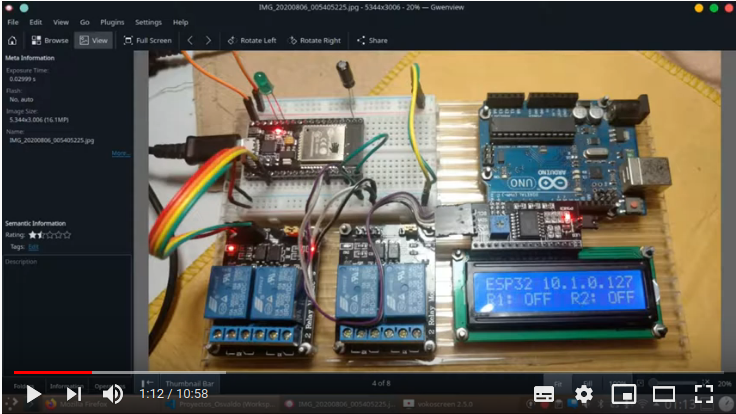
En este ejemplo usaremos el Espressif ESP32 funcionando como servidor web con conexión WiFi, alojando una página web que permite controlar el estado on-off de dos relés. Esto puede ser útil para manejar elementos conectados a 110VAC o 220VAC, como motores, electroválvulas, contactores, etc.

A continuación vemos el código fuente que permite utilizar el ESP32 como Web Server
/*********
Servidor web con ESP32
Incluye un lcd H44780 conectado via bus I2C. La dirección IP obtenida via
protocolo DHCP en el display.
El display también muestra el estado de cada uno de dos relés conectados al microcontrolador y manejados mediante elcódigo HTML.
Este sketch se basa en elejemplo de Rui Santos
y fue editado y adaptado por mí en Ramos Mejía, ARGENTINA, Agosto 2020.
- Osvaldo Cantone correo@cantone.com.ar
reles:
Relé1 GPIO.15
Relé2 GPIO.2
display:
SDA GPIO.21
SCL GPIO.22
*********/
#include <Arduino.h>
#include <WiFi.h>
#include <LiquidCrystal_PCF8574.h>
#include <Wire.h>
LiquidCrystal_PCF8574 lcd(0x27); // setea la dirección del LCD en 0x27
// Reemplazar las X's con sus credenciales de red
const char* ssid = "XXXXXXXXXXXXX";
const char* password = "XXXXXXXXXXXXX";
// Setea el puerto de web server en 80
WiFiServer server(80);
// Variable tipo String que almacena la HTTP request
String header;
// Variables output state
String relay1State = "off";
String relay2State = "off";
// Assign output variables to GPIO pins
//const int output26 = 26;
//const int output27 = 27;
const int Relay1 = 15;
const int Relay2 = 2;
// Current time
unsigned long currentTime = millis();
// Previous time
unsigned long previousTime = 0;
// Define timeout time in milliseconds (example: 2000ms = 2s)
const long timeoutTime = 2000;
int show = -1;
void setup() {
int error;
Serial.begin(9600);
// Initialize the output variables as outputs
pinMode(Relay1, OUTPUT);
pinMode(Relay2, OUTPUT);
// Set outputs to LOW
digitalWrite(Relay1, LOW);
digitalWrite(Relay2, LOW);
//Initializing the display
Wire.begin();
Wire.beginTransmission(0x27);
error = Wire.endTransmission();
Serial.print("Error: ");
Serial.print(error);
if (error == 0) {
Serial.println(": LCD found.");
show = 0;
lcd.begin(16, 2); // initialize the lcd
} else {
Serial.println(": LCD not found.");
} // if
lcd.setBacklight(255);
lcd.home();
lcd.clear();
lcd.setCursor(0, 0);
// lcd.print("0123456789ABCDEF");
lcd.print(" ESP32 WebSerer ");
// Connect to Wi-Fi network with SSID and password
Serial.print("Connecting to ");
Serial.println(ssid);
WiFi.begin(ssid, password);
while (WiFi.status() != WL_CONNECTED) {
delay(500);
Serial.print(".");
}
// Print local IP address and start web server
Serial.println("");
Serial.println("WiFi connected.");
Serial.println("IP address: ");
Serial.println(WiFi.localIP());
lcd.setCursor(0, 1);
lcd.print(WiFi.localIP());
delay(2000);
lcd.setCursor(0, 0);
lcd.print("ESP32 ");
lcd.print(WiFi.localIP());
lcd.setCursor(0, 1);
lcd.print("R1: ON R2: ON ");
server.begin();
}
void loop(){
WiFiClient client = server.available(); // Listen for incoming clients
if (client) { // If a new client connects,
currentTime = millis();
previousTime = currentTime;
Serial.println("New Client."); // print a message out in the serial port
String currentLine = ""; // make a String to hold incoming data from the client
while (client.connected() && currentTime - previousTime <= timeoutTime) { // loop while the client's connected
currentTime = millis();
if (client.available()) { // if there's bytes to read from the client,
char c = client.read(); // read a byte, then
Serial.write(c); // print it out the serial monitor
header += c;
if (c == '\n') { // if the byte is a newline character
// if the current line is blank, you got two newline characters in a row.
// that's the end of the client HTTP request, so send a response:
if (currentLine.length() == 0) {
// HTTP headers always start with a response code (e.g. HTTP/1.1 200 OK)
// and a content-type so the client knows what's coming, then a blank line:
client.println("HTTP/1.1 200 OK");
client.println("Content-type:text/html");
client.println("Connection: close");
client.println();
// turns the GPIOs on and off
if (header.indexOf("GET /26/on") >= 0) {
Serial.println("GPIO 26 on");
relay1State = "on";
digitalWrite(Relay1, HIGH);
lcd.setCursor(4, 1);
lcd.print("OFF");
} else if (header.indexOf("GET /26/off") >= 0) {
Serial.println("GPIO 26 off");
relay1State = "off";
digitalWrite(Relay1, LOW);
lcd.setCursor(4, 1);
lcd.print("ON ");
} else if (header.indexOf("GET /27/on") >= 0) {
Serial.println("GPIO 27 on");
relay2State = "on";
digitalWrite(Relay2, HIGH);
lcd.setCursor(13, 1);
lcd.print("OFF");
} else if (header.indexOf("GET /27/off") >= 0) {
Serial.println("GPIO 27 off");
relay2State = "off";
digitalWrite(Relay2, LOW);
lcd.setCursor(13, 1);
lcd.print("ON ");
}
// Display the HTML web page
client.println("<!DOCTYPE html><html>");
client.println("<head><meta name=\"viewport\" content=\"width=device-width, initial-scale=1\">");
client.println("<link rel=\"icon\" href=\"data:,\">");
// CSS to style the on/off buttons
// Feel free to change the background-color and font-size attributes to fit your preferences
client.println("<style>html { font-family: Helvetica; display: inline-block; margin: 0px auto; text-align: center;}");
client.println(".button { background-color: #4CAF50; border: none; color: white; padding: 16px 40px;");
client.println("text-decoration: none; font-size: 30px; margin: 2px; cursor: pointer;}");
client.println(".button2 {background-color: #555555;}</style></head>");
// Web Page Heading
client.println("<body><h1>ESP32 Web Server</h1>");
client.println("<p>Adapted by Osvaldo Cantone <a href=http://www.cantone.com.ar/wordpress/esp32-web-server-relay-control-lcd-i2c-display/>tecteach.net</a> </p>");
// Display current state, and ON/OFF buttons for GPIO 26
client.println("<p>Relay 1 (GPIO 15) - State: " + relay1State + "</p>");
// If the output26State is off, it displays the ON button
if (relay1State=="off") {
client.println("<p><a href=\"/26/on\"><button class=\"button\">ON</button></a></p>");
} else {
client.println("<p><a href=\"/26/off\"><button class=\"button button2\">OFF</button></a></p>");
}
// Display current state, and ON/OFF buttons for GPIO 27
client.println("<p>Relay 2 (GPIO 2) - State: " + relay2State + "</p>");
// If the output27State is off, it displays the ON button
if (relay2State=="off") {
client.println("<p><a href=\"/27/on\"><button class=\"button\">ON</button></a></p>");
} else {
client.println("<p><a href=\"/27/off\"><button class=\"button button2\">OFF</button></a></p>");
}
client.println("</body></html>");
// The HTTP response ends with another blank line
client.println();
// Break out of the while loop
break;
} else { // if you got a newline, then clear currentLine
currentLine = "";
}
} else if (c != '\r') { // if you got anything else but a carriage return character,
currentLine += c; // add it to the end of the currentLine
}
}
}
// Clear the header variable
header = "";
// Close the connection
client.stop();
Serial.println("Client disconnected.");
Serial.println("");
}
}